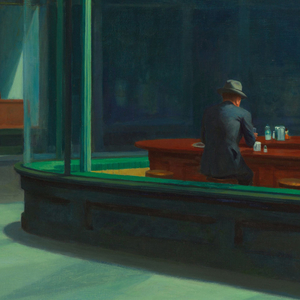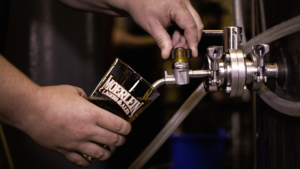 We’re half-way through shooting for the craft documentary. Today’s shoot was at Christian Moerlein Brewing Company and we got some really great footage and interviews. Having total access to such an historic institution, with such great people, was (pardon the pun) intoxicating. There were so many great things to film, and even though the facility is huge (roughly 100,000 square feet of huge), it’s clear that this brewery takes pride in continuing their 162-year-old tradition of hands-on craft brewing, in everything they make.
We’re half-way through shooting for the craft documentary. Today’s shoot was at Christian Moerlein Brewing Company and we got some really great footage and interviews. Having total access to such an historic institution, with such great people, was (pardon the pun) intoxicating. There were so many great things to film, and even though the facility is huge (roughly 100,000 square feet of huge), it’s clear that this brewery takes pride in continuing their 162-year-old tradition of hands-on craft brewing, in everything they make.
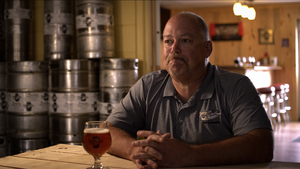 This is Jeff Graff, the owner and brew master of Paradise Brewing. He’s one of the many great people that I’ve had the pleasure to interview during the production of the short documentary I’m currently directing, about the resurgence of craft brewing. This shot is a color test from a clip of the interview. So far, so good! It airs this September. More details to follow.
This is Jeff Graff, the owner and brew master of Paradise Brewing. He’s one of the many great people that I’ve had the pleasure to interview during the production of the short documentary I’m currently directing, about the resurgence of craft brewing. This shot is a color test from a clip of the interview. So far, so good! It airs this September. More details to follow.
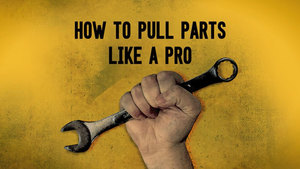 It was a busy winter, and among the several spots I’ve produced during what I feel is the ugliest of Mother Nature’s seasons (ever wonder why they call her “Mother”?), I thought I’d post a couple commercials that I produced for U Pull & Pay. Not only am I happy with the outcome, but producing these spots allowed me to remain indoors, during Frau Frostbite’s more inhospitable tantrums. (Translation: sub-zero weather and mountains of snow).
It was a busy winter, and among the several spots I’ve produced during what I feel is the ugliest of Mother Nature’s seasons (ever wonder why they call her “Mother”?), I thought I’d post a couple commercials that I produced for U Pull & Pay. Not only am I happy with the outcome, but producing these spots allowed me to remain indoors, during Frau Frostbite’s more inhospitable tantrums. (Translation: sub-zero weather and mountains of snow).
At first blush, you would think that U Pull & Pay is just another auto graveyard, but you’d be mistaken. This is not some local junk yard, piled high with tetanus inducing car sandwiches that sport pieces of jagged metal, and sit in chemical cesspools. This is a highly organized, efficient, award winning, and well maintained, self-serve used auto parts company, with nine locations across the United States. But that’s literarly just the half of it.
In addition to being able to find your auto parts online, and then walk into their yard to retrieve said parts, at a pretty reasonable price, you can also have your car… or more specifically, your junked car, hauled away. They even pay you for the privilege, based on the value of your unwanted vehicle. Yes. They pay you! Ah… the cycle of life.
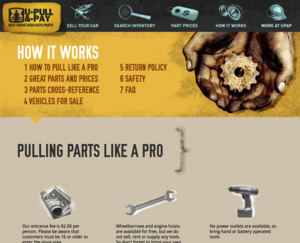 They already had a great brand and design in place, so the challenge (and fun) of creating TV commercials for them, was to bring their existing style and attitude to life. We went with the gritty, stylized look they had established in their print pieces and on their website. Casting was simple, as there wouldn’t be any on camera dialogue. In fact, there would not be any on camera action, either. Everything would be shot in still frames, just short of stop-frame animation, including the mass of props we’d need to gather.
They already had a great brand and design in place, so the challenge (and fun) of creating TV commercials for them, was to bring their existing style and attitude to life. We went with the gritty, stylized look they had established in their print pieces and on their website. Casting was simple, as there wouldn’t be any on camera dialogue. In fact, there would not be any on camera action, either. Everything would be shot in still frames, just short of stop-frame animation, including the mass of props we’d need to gather.
And when I say “mass of props,” I’m not exaggerating. It took a couple of trips to hardware stores, 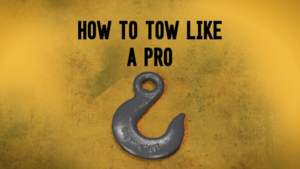 and tractor supply outlets, to get everything we needed, from crescent wrenches to towing hooks, screw drivers, crowbars, and even an old telephone. A total of some 50-plus items were assembled, in what I can honestly say is the largest prop list I’ve ever created. All of this, including the three male talents, would be composited and animated in After Effects.
and tractor supply outlets, to get everything we needed, from crescent wrenches to towing hooks, screw drivers, crowbars, and even an old telephone. A total of some 50-plus items were assembled, in what I can honestly say is the largest prop list I’ve ever created. All of this, including the three male talents, would be composited and animated in After Effects.
Sound design was our next concern. The voice over needed to be male, blue collar, and ‘dead-pan’ in delivery. I always loved Hoyt Axton’s bass-baritone voice on the Busch Beer commercials back in the 80’s. It was the kind of voice style that I wanted for these commercials: manly, wise, and matter-of-fact. This isn’t to say that women don’t pull parts, or need their junked cars carted away. I’m sure they do. In fact, I know they do. But remember, we’re matching the look and feel of an existing brand and going for a predominantly male audience.
Along with this voice over, we opted to forgo music, and instead, go with some sound-scaping, using accented effects to reinforce the imagery and action on screen. Gathering these effects was almost as time consuming as was the sourcing of props (though admittedly, far easier than running around to every farm/mechanic/contractor store in the area). Of all the sound effects, the most important is the sound of an engine firing up, at the end. It was the final accent that tied together the whole point of both spots; this is easy.
I’m pretty happy with the way both spots turned out. The process went smoothly, throughout, from concept approval, to production and post. Best of all, the client was happy with them, too. Have a look:
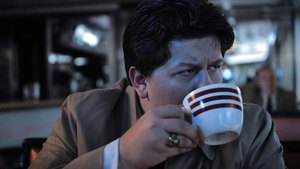 The heart of any ‘noir-style’ piece, is darkness… night shots… shadows, etc. I was presented with a serious challenge to achieving this look, however, when I secured the diner location. They opened for business at 4pm, and didn’t close until 4am, and we didn’t have it in our budget to close them down for a day. So, this meant that if I wanted to use the diner, I was going to have to shoot during daylight hours. Given that the entire front of the diner was composed of large windows, lighting was going to be a major issue. Essentially, I’d have to shoot ‘day for night’. I hate ‘day for night’ shots, as they never look convincing to me, no matter the budget or talent involved. You can always tell.
The heart of any ‘noir-style’ piece, is darkness… night shots… shadows, etc. I was presented with a serious challenge to achieving this look, however, when I secured the diner location. They opened for business at 4pm, and didn’t close until 4am, and we didn’t have it in our budget to close them down for a day. So, this meant that if I wanted to use the diner, I was going to have to shoot during daylight hours. Given that the entire front of the diner was composed of large windows, lighting was going to be a major issue. Essentially, I’d have to shoot ‘day for night’. I hate ‘day for night’ shots, as they never look convincing to me, no matter the budget or talent involved. You can always tell.
We also didn’t have the luxury of extra time in our schedule, to compensate for the world’s largest light source, should it appear in all it’s radiant glory on our shoot day. We’d have to work faster and smarter, to get what we wanted. I took my videographer to the diner, for lunch, and to get an idea of what needed to be done on our shoot. We felt reasonably confident that between clever lighting and color correction, we’d be able to get the look that we wanted. Nevertheless, we both crossed our fingers for a cloudy shoot day.
 Casting was a little bit easier. The main character was (as always) the most important casting call. I looked through a few options and settled on someone who’d be recommended to me by the client. He was much younger than what I had in mind, but he could give a cold, dead stare… and his voice! Amazing! After hearing it, my first thought was, “what is this guy doing in Cincinnati?”, and I knew I had my guy. The role of the cook was selected, and would also be used in the 2nd spot of the campaign. The role of ‘lonely guy in the back’, was a friend of the client’s, who just wanted to be in the spot. As there were no speaking parts for that role, I was happy to oblige.
Casting was a little bit easier. The main character was (as always) the most important casting call. I looked through a few options and settled on someone who’d be recommended to me by the client. He was much younger than what I had in mind, but he could give a cold, dead stare… and his voice! Amazing! After hearing it, my first thought was, “what is this guy doing in Cincinnati?”, and I knew I had my guy. The role of the cook was selected, and would also be used in the 2nd spot of the campaign. The role of ‘lonely guy in the back’, was a friend of the client’s, who just wanted to be in the spot. As there were no speaking parts for that role, I was happy to oblige.
With casting out of the way, along with wardrobe (pretty straight-forward stuff), I had one element that I wanted to add, specifically for the shoot… coffee cups. I didn’t want the modern day version of coffee mugs that you find in coffee shops and restaurants. The chunky, squarish, plain mugs weren’t going to cut it, and that’s precisely what the restaurant had to offer. 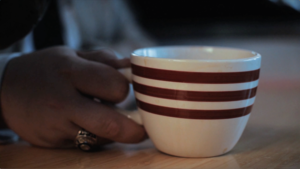 I wanted something that looked like it belonged, while at the same time, having a little flair. It’s a small thing, but if I’ve learned anything in over 25 years of making pictures, it’s that these little elements can go a long way towards selling the whole piece, visually. I thought for sure that I was going to have to hit the antique and consignment shops, to find what I was looking for, but on my way, I decided to hit the local Target store… and lo and behold, there they were. Perfect. Not over the top. They looked like coffee cups from another era. $10 or so later, I walked with two of them.
I wanted something that looked like it belonged, while at the same time, having a little flair. It’s a small thing, but if I’ve learned anything in over 25 years of making pictures, it’s that these little elements can go a long way towards selling the whole piece, visually. I thought for sure that I was going to have to hit the antique and consignment shops, to find what I was looking for, but on my way, I decided to hit the local Target store… and lo and behold, there they were. Perfect. Not over the top. They looked like coffee cups from another era. $10 or so later, I walked with two of them.
As to the gear used for the shoot, in keeping with the goal of achieving a more ‘filmic’ look while shooting on DSLR, I decided to use a 35mm prime lens. This would allow for detailed focus on the subject along with great color capture, while causing the rest of the scene to be thrown out of focus. Regarding audio, if any of you have shot video using a DSLR before, you’ll know that in most cases, the audio tends to be nothing more than a reference capture, so we ended up using an outboard mixer to capture the sound to a separate memory card. It’s for this reason that I insisted on using a slate for all shots (much to the initial chagrin of my crew). I opted to use an iPad app called Movie Slate. It works just as a traditional slate would, with the added bonus of generating a log for use in synching up material, at the end of production. It’s a little pricey in comparison to the average cost of apps, but for all that it does, it’s worth every penny, and then some.
As I mentioned, we were hoping for a gloomy, cloudy day for our shoot. It would at least mitigate some of the daylight properties that would spill into our scene. Mother nature, however, was not going to cooperate, and instead gave us the most brilliantly sunny day possible. Fortunately, we had expected as much, and had prepared to do a dreaded ‘day-for-night’ shoot. Between blocking and lighting (lots of gels, and black tarps/foam-core), we were able to get what we thought would work, after color correction. The production went as smoothly as I could have wanted. The talent were all spot on, and our main guy, nailed every take, to the extent that I was throwing out alternate actions and delivery to him, just to have a bit of fun, and to see what I could get. He never missed a beat.
We wrapped on time, and I was anxious to get back to the studio to view the footage. We’ve all grown accustomed to the immediacy of video. Even more so with digital, where you can view footage on practically any computer. But I remembered well, a time when we would shoot on film, and this would be the stage of ‘wait and worry’. It would have been days until we’d get the dailies back, and could verify that the film had captured everything as we’d hoped. Now, we had checked shots in between takes, right on the camera, and within an hour after we wrapped, I was back at the studio, viewing the footage with a smile on my face. Everything looked great.
I’ll cover my editing process at another time, but once my edit was completed, I turned to color correction. All of the hard work we had put into making the scene shadow and illuminate, as though it were shot at night, paid off. This truly was one of the easiest color grading I’ve ever done, and it was all due to the lens, the lighting, and ultimately, the crew. I had been searching for just the right ambient tracks, as well as music, since the beginning of the project, and the audio post was also a relative breeze to do. It reflected the exact mood, and feel I’d hoped to achieve. yet something was still missing.
Even though I felt the color correction was spot on, and convincing as a night-time shot, I still worried that I might just be fooling myself, and wondered if there might not be an element that could be added, to completely sell the ‘lie’. The spot itself looked great. The edit flowed. The story was told. But it kept feeling like something was missing. 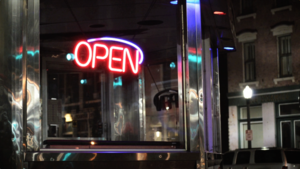 Then it ocurred to me. While we couldn’t get exteriors of the diner, showing our character inside, due to the fact that it was broad daylight, and shooting a shiny, aluminum diner would have been out of the question, I could grab a shot of the diner’s doorway, which had a neon ‘OPEN’ sign. It was the missing piece. If used at the very beginning, it would without a doubt, sell the idea that the scenes all happened at night. It also tied in nicely (if not subtly) with the client’s message of being open nights and weekends. Once we had that shot, and dropped it into the spot, we had a finished piece.
Then it ocurred to me. While we couldn’t get exteriors of the diner, showing our character inside, due to the fact that it was broad daylight, and shooting a shiny, aluminum diner would have been out of the question, I could grab a shot of the diner’s doorway, which had a neon ‘OPEN’ sign. It was the missing piece. If used at the very beginning, it would without a doubt, sell the idea that the scenes all happened at night. It also tied in nicely (if not subtly) with the client’s message of being open nights and weekends. Once we had that shot, and dropped it into the spot, we had a finished piece.
I’m happy to say that the client loved the spot, right from the first viewing, and it has aired ever since, some nearly 6 months later. There is a companion spot that I might discuss in a later post. It continues to run, as well. Overall, the experience from concept to screen was thoroughly satisfying, even with some of the little challenges that popped up, along the way. There may be future spots in this vein, that I’ll be creating for this client. I’d like to do at least one more, and have a ‘trilogy’ of them. They really were fun to do, and made for a nice spin on the Edward Hopper look, even though I wasn’t the first to be inspired by his work, and I’m certain to not be the last.
“It’s a graveyard charade, it’s a late shift masquerade…” – ‘Eggs & Sausage (In a Cadillac with Susan Michelson)’ – by Tom Waits
Recently, crime novelist, James Ellroy said in an interview (Written by Barry Forshaw for The Independent ) that the idea for his novel, LA Confidential “came to me as something of a synoptic flash, and in the backlash of that flash, I realised that whatever I could conceive, I could execute. It was a seismic, life-changing moment.” As I’d mentioned in Part 01 of this article, the ideas for the commercial campaign I am discussing, came about in very much the same manner. Particularly for the first of the two commercials, Mean Streets.
In my mind, I saw the diner, at night, dark, and almost empty. I saw the cook, wandering around with a pot of coffee, refiling cold, empty cups. I saw one lonely customer, empty and hollow, sitting so far in the back that you couldn’t make out his features. Finally, I saw the main character. He’s the one who will deliver our message. In order for him to be able to deliver that message, he had to have experienced some of the things that the viewer might face, when needing an attorney. At the same time, he’d also have to possess a certain ‘street-wise’ sensibility about him, that would convey that he knew what he was talking about. When you put a character like that inside a mid-century diner, late at night, you end up with a pretty familiar motif… namely someone like Raymond Chandler’s Phillip Marlowe.
What I liked about Chadler’s novels, was that outside of the dialogue between Marlowe and the other characters, most of what you read was Marlowe’s own internal dialogue. This included describing the other characters, and places, etc. It all came from inside his head. I wanted to use that method. I wanted our character to speak through his thoughts, and not to other characters. This would allow bits of action to happen around him, without an interruption of the storyline, and would allow the audience to be there, sitting across the booth from him, instead of being just a voyeur, watching the action of others through a TV screen. Our character’s thoughts, would be speaking to you.
I didn’t want to do a parody of Marlowe, mind you. I only wanted the mood and feel of such a character. We don’t ever really know who the character is, or what he does for a living, much less why he’s there at the diner, in the first place. Not knowing those things wouldn’t matter, if the dialogue worked. The result was as follows:
“At night, it’s a different world out there… cold… dangerous… anything can happen. Car wrecks, personal injury… you name it. And when it happens, you can feel like you’re all alone out there. Believe me, I know what it’s like. I’m out there, night after night. Just like the law firm of Gregory S. Young. They’re around when you need them. All night, every night. Even weekends. Because in this world, trouble never sleeps. If you need ‘em, call ‘em.”
This was the copy I ended up writing. I tried to cover all of my goals. I set up the problem and I phrased it as a warning; “anything can happen… And when it happens, you can feel like you’re all alone out there.” I gave my main character authority; “I know what it’s like. I’m out there, night after night.” Then I had my main character endorse another entity (my client) by having him say they’re out there, too, all night, every night, and they know what it’s like. Then, with another nod to the look and mood I was after, I came up with what sounded to me like a Chandler or Ellroy novel that never was; Trouble Never Sleeps. The closing lines were to be delivered ‘live’, and to the camera, breaking the 4th wall. In doing so, I’d hoped to make the viewer feel as though they were being spoken to by someone on their side. The break from the inner dialogue (which served to make the viewer feel as isolated as the characters at the diner) to the final lines spoken to the viewer, broke the isolation I’d set up in the first few seconds of the commercial. It implied that ‘insider knowledge’ or advice that was being given to them personally, by a confidante they could trust.
This is not to say that anyone would take all of this literally, much less seriously, beyond the idea that my client’s message was genuine (we can be reached 24/7). The connection is still made, even though no one would believe this character, or the world he inhabits, is real. It’s the psychological elements, presented within familiar tropes, that make it real enough to deliver the message.
In the next and final part, I’ll cover the production process, from wardrobe, props, casting, location, lighting, and some of the challenges that befell us, while capturing the images.
